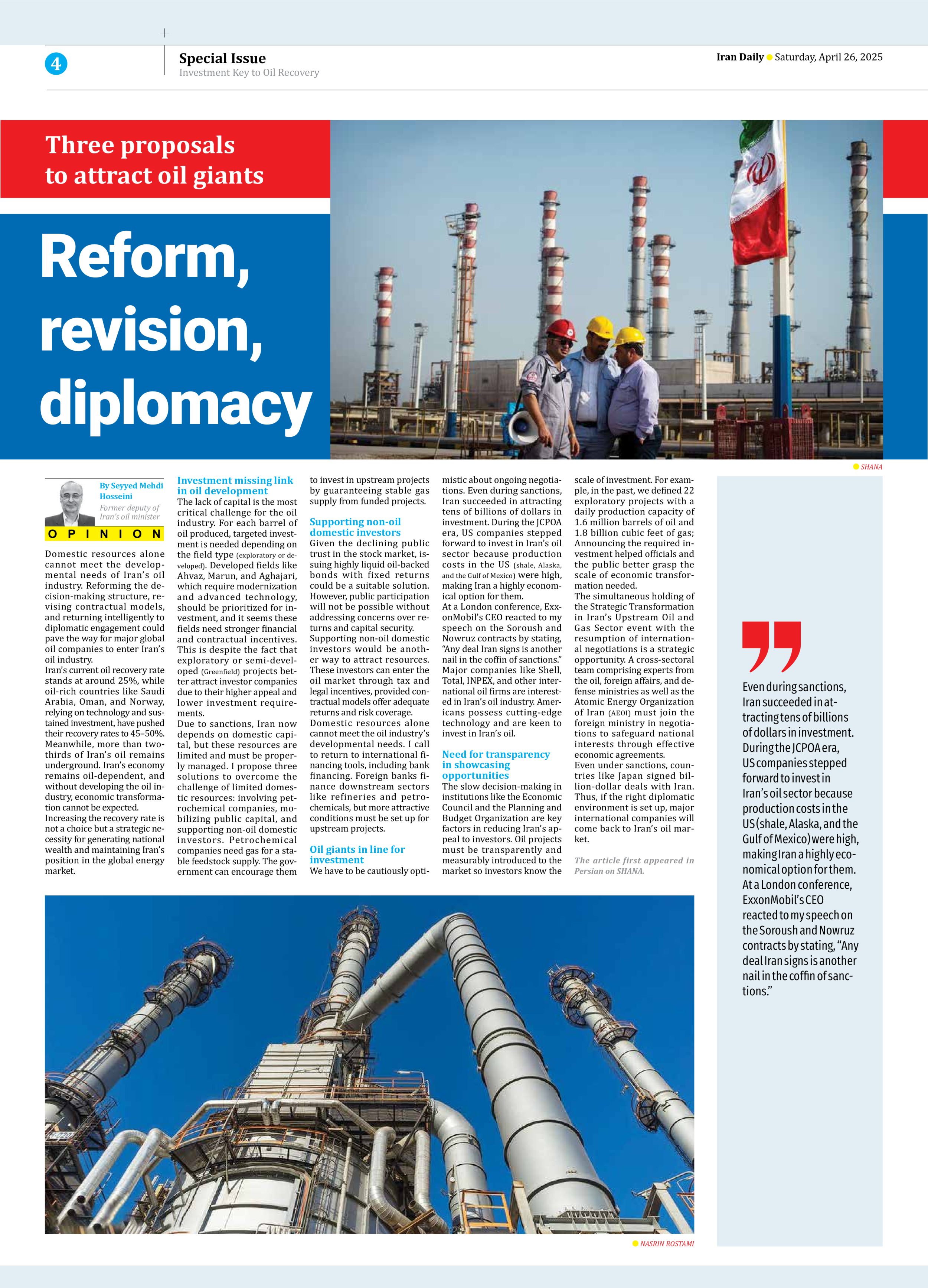
Three proposals to attract oil giants
Reform, revision, diplomacy
By Seyyed Mehdi Hosseini
Former deputy of Iran’s oil minister
Domestic resources alone cannot meet the developmental needs of Iran’s oil industry. Reforming the decision-making structure, revising contractual models, and returning intelligently to diplomatic engagement could pave the way for major global oil companies to enter Iran’s oil industry.
Iran’s current oil recovery rate stands at around 25%, while oil-rich countries like Saudi Arabia, Oman, and Norway, relying on technology and sustained investment, have pushed their recovery rates to 45–50%. Meanwhile, more than two-thirds of Iran’s oil remains underground. Iran’s economy remains oil-dependent, and without developing the oil industry, economic transformation cannot be expected.
Increasing the recovery rate is not a choice but a strategic necessity for generating national wealth and maintaining Iran’s position in the global energy market.
Investment missing link in oil development
The lack of capital is the most critical challenge for the oil industry. For each barrel of oil produced, targeted investment is needed depending on the field type (exploratory or developed). Developed fields like Ahvaz, Marun, and Aghajari, which require modernization and advanced technology, should be prioritized for investment, and it seems these fields need stronger financial and contractual incentives. This is despite the fact that exploratory or semi-developed (Greenfield) projects better attract investor companies due to their higher appeal and lower investment requirements.
Due to sanctions, Iran now depends on domestic capital, but these resources are limited and must be properly managed. I propose three solutions to overcome the challenge of limited domestic resources: involving petrochemical companies, mobilizing public capital, and supporting non-oil domestic investors. Petrochemical companies need gas for a stable feedstock supply. The government can encourage them to invest in upstream projects by guaranteeing stable gas supply from funded projects.
Supporting non-oil domestic investors
Given the declining public trust in the stock market, issuing highly liquid oil-backed bonds with fixed returns could be a suitable solution. However, public participation will not be possible without addressing concerns over returns and capital security.
Supporting non-oil domestic investors would be another way to attract resources. These investors can enter the oil market through tax and legal incentives, provided contractual models offer adequate returns and risk coverage.
Domestic resources alone cannot meet the oil industry’s developmental needs. I call to return to international financing tools, including bank financing. Foreign banks finance downstream sectors like refineries and petrochemicals, but more attractive conditions must be set up for upstream projects.
Oil giants in line for investment
We have to be cautiously optimistic about ongoing negotiations. Even during sanctions, Iran succeeded in attracting tens of billions of dollars in investment. During the JCPOA era, US companies stepped forward to invest in Iran’s oil sector because production costs in the US (shale, Alaska, and the Gulf of Mexico) were high, making Iran a highly economical option for them.
At a London conference, ExxonMobil’s CEO reacted to my speech on the Soroush and Nowruz contracts by stating, “Any deal Iran signs is another nail in the coffin of sanctions.”
Major companies like Shell, Total, INPEX, and other international oil firms are interested in Iran’s oil industry. Americans possess cutting-edge technology and are keen to invest in Iran’s oil.
Need for transparency in showcasing opportunities
The slow decision-making in institutions like the Economic Council and the Planning and Budget Organization are key factors in reducing Iran’s appeal to investors. Oil projects must be transparently and measurably introduced to the market so investors know the scale of investment. For example, in the past, we defined 22 exploratory projects with a daily production capacity of 1.6 million barrels of oil and 1.8 billion cubic feet of gas; Announcing the required investment helped officials and the public better grasp the scale of economic transformation needed.
The simultaneous holding of the Strategic Transformation in Iran’s Upstream Oil and Gas Sector event with the resumption of international negotiations is a strategic opportunity. A cross-sectoral team comprising experts from the oil, foreign affairs, and defense ministries as well as the Atomic Energy Organization of Iran (AEOI) must join the foreign ministry in negotiations to safeguard national interests through effective economic agreements.
Even under sanctions, countries like Japan signed billion-dollar deals with Iran. Thus, if the right diplomatic environment is set up, major international companies will come back to Iran’s oil market.
The article first appeared in Persian on SHANA.







